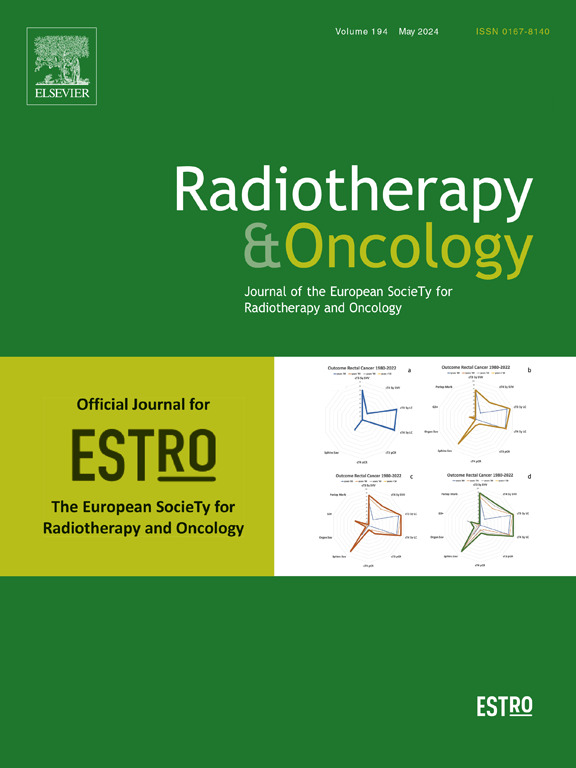Prognostic gene expression signatures for HPV-negative head and neck squamous cell carcinoma
IF 4.9
1区 医学
Q1 ONCOLOGY
引用次数: 0
Abstract
Background
Head and neck squamous cell carcinoma (HNSCC) is a leading cause of cancer-related deaths worldwide, with HPV-negative cases being particularly aggressive. These cases often show poor prognosis and low responsiveness to radiotherapy. Improved prognostic tools and treatment strategies are needed to enhance outcomes.
Aim
To evaluate the prognostic value of various gene expression signatures in predicting survival outcomes in HPV-negative HNSCC patients receiving radiotherapy and to compare their accuracy against the current TNM staging system.
Methods
This observational cohort study used data from the European BD2Decide project, systematically analyzing gene expression in loco-regionally advanced, non-metastatic HPV-negative HNSCC patients (stage III-IVa/b) treated with curative radiotherapy (post-operative or definitive) between 2008 and 2017. The primary outcome was overall survival (OS), with secondary outcomes including disease-free survival (DFS), distant metastasis-free survival (DMFS), and loco-regional recurrence-free survival (LRRFS). The prognostic performance of selected gene expression signatures was evaluated using receiver operating characteristic (ROC) curves and hazard ratios (HR) from Cox models.
Results
The study included 783 patients, with a median age of 63 years, mostly male (68 %), with significant tobacco (84 %) and alcohol (69 %) exposure. The 172-gene signature (172GS) showed the highest prognostic accuracy, outperforming the TNM system in predicting OS, DFS, DMFS, and LRRFS. Multivariable analysis confirmed its independent prognostic value.
Conclusions
The 172GS gene signature offers superior prognostic information compared to TNM staging, supporting its potential use for better risk stratification and personalized treatment planning in HPV-negative HNSCC. Future trials should consider tumor biology and gene signatures for better patient selection.
Trial Registration: NCT02832102.
hpv阴性头颈部鳞状细胞癌的预后基因表达特征
背景头颈部鳞状细胞癌(HNSCC)是全球癌症相关死亡的主要原因,hpv阴性病例尤其具有侵袭性。这些病例通常表现为预后差,对放射治疗反应低。需要改进预后工具和治疗策略来提高结果。目的评估各种基因表达特征在预测hpv阴性HNSCC放疗患者生存结局中的预后价值,并将其与当前TNM分期系统的准确性进行比较。方法:本观察性队列研究使用欧洲BD2Decide项目的数据,系统分析2008年至2017年间接受根治性放疗(术后或终末期)治疗的局部-区域晚期、非转移性hpv阴性HNSCC患者(III-IVa/b期)的基因表达。主要终点是总生存期(OS),次要终点包括无病生存期(DFS)、无远处转移生存期(DMFS)和局部-区域无复发生存期(LRRFS)。采用Cox模型的受试者工作特征(ROC)曲线和风险比(HR)评估选定基因表达特征的预后表现。结果该研究纳入783例患者,中位年龄63岁,大多数为男性(68%),有明显的烟草(84%)和酒精(69%)暴露。172基因标记(172GS)显示出最高的预后准确性,在预测OS、DFS、DMFS和LRRFS方面优于TNM系统。多变量分析证实了其独立的预后价值。结论与TNM分期相比,172GS基因标记提供了更好的预后信息,支持其在hpv阴性HNSCC中更好的风险分层和个性化治疗计划的潜在应用。未来的试验应考虑肿瘤生物学和基因特征,以更好地选择患者。试验注册:NCT02832102。
本文章由计算机程序翻译,如有差异,请以英文原文为准。
求助全文
约1分钟内获得全文
求助全文
来源期刊

Radiotherapy and Oncology
医学-核医学
CiteScore
10.30
自引率
10.50%
发文量
2445
审稿时长
45 days
期刊介绍:
Radiotherapy and Oncology publishes papers describing original research as well as review articles. It covers areas of interest relating to radiation oncology. This includes: clinical radiotherapy, combined modality treatment, translational studies, epidemiological outcomes, imaging, dosimetry, and radiation therapy planning, experimental work in radiobiology, chemobiology, hyperthermia and tumour biology, as well as data science in radiation oncology and physics aspects relevant to oncology.Papers on more general aspects of interest to the radiation oncologist including chemotherapy, surgery and immunology are also published.
 求助内容:
求助内容: 应助结果提醒方式:
应助结果提醒方式:


